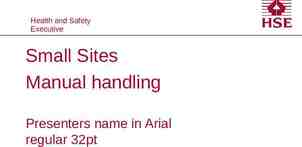Multi-State Nursing Licensure JENNIFER AMES & ANGELA MCCOLL FERRIS
7 Slides8.96 MB

Multi-State Nursing Licensure JENNIFER AMES & ANGELA MCCOLL FERRIS STATE UNIVERSITY

Nursing Shortage “A significant amount of the nursing workforce is nearing retirement age. The Health Resources and Services Administration projects that more than 1 million registered nurses will reach retirement age within the next 10 to 15 years” (American Association of Colleges of Nursing, 2014) Multi-State Nurse Licensure Compact would remove barriers of bringing nurses into the state to meet the immediate nursing shortage needs. Additionally the compact would provide faster notification of nurses under investigation and improve access to other states’ records. Simply, the ease of transitioning from state to state and will be beneficial in decreasing nursing shortages. Nursing License History 1903: single state nursing licensure model was established based on the 10th Amendment. Evolved state by state to meet their needs. Model limits the nurse to practice within the boundaries of the state that issued the license. In order to practice in another state an additional license is required. The process is lengthy, costly, and requires repetitive paperwork.

Multi State Nursing Licensure Compact History Defined- The compact allows all licensed practical and registered nurses to practice in all states that participate, with the requirement of maintaining a single license in their primary state of residence. Established in 2000 with 4 states joining compact Maryland, Texas, Utah, and Wisconsin As of 2015, 25 states now a member of the compact. There are 5 more with pending legislation. Michigan is not currently part of the compact or have pending legislation. The Nursing Compact is similar to a driver’s license when crossing state lines. Licensee in state A can practice in state A and state B, but when in state B they must follow the laws of State B. (NCSBN, 2015)

Beneficial Attributes of the Compact Nurses have the benefit of being able to practice across many state lines and facilitates mobility. Nursing practice no longer restricted by geographic boundaries. Greater access to an experienced workforce. Alleviation of cumbersome paperwork and costly fees in obtaining multiple licenses. Reduces redundant regulatory processes. (Poe, 2008) (Erickson, 2012) State boards of nursing reach new levels of cooperation and coordination. Discipline history of nurses housed in one database: Nursys. Drives states to adopt uniform standards such as criminal background checks and disclosure of substance abuse. The compact does not require nurses in participating states to obtain endorsements allowing nurses to practice in another state quickly. Allows for easy influx of nurses when needed in times of natural disasters, often within 2 days. Negative implications to the Compact Variability in State Practice acts A nurse who is competent to practice a particular task in one state may be barred to perform in another (Munro, 2012). Patient may perceive an interruption in quality of care, especially in cities by state boundaries. Increased responsibility and competence of the RN working under different Nurse Practice Acts in each state. Nursing compact does not relieve the nursing shortage. There are still the same number of nurses available. Inconsistencies between states in requirements for maintaining nurse licensure. Lowered nursing standards of practice in certain states.

Differences in Continuing Education (CE) Requirements: Is this a Patient Safety Issue? Iowa: 36hrs including course on child/dependant abuse North Dakota: 12hrs of CE Arizona: CE not required Tennessee: CE for relicensure is not mandatory, nurses just have to practice in last five years Delaware: 30hrs of CE every 2 years Colorado: CE not required (Pearls Review, 2008) Nebraska: 20hrs of CE within renewal period. 10hrs must be formally peer reviewed and 4hrs may be BLS courses Kentucky: 14hrs or national certification, or completion of research project, or publication in nursing article, or professional nursing presentation, or participate as a preceptor, or 7hrs and satisfactory nursing employment evaluation

Recommendations Assess effectiveness of Nurse Licensure Compact by having each individual state board report efficacy of the NLC one year after implementation for new members. Identify states ability to obtain nurses during short-term nursing demands. Each state should assess the number of legal issues per compact nurse compared to the number of legal issues of nurses with state licenses. Each state should achieve a consensus regarding continuing education requirements to eliminate inequities. Evaluate the establishment of an uniform Nurse Practice Act and eliminate the variability in nursing scope of practice. Conclusion Multi-state licensure allows nurses to practice in multiple states without having to hold multiple state licenses, it enables mobility, and decreases barriers when immediate nursing needs are required. Increases quality of patient care through an established workforce and availability of nurses. Allows state boards to achieve greater cooperation and communication and build upon already established systems. The Nurse Licensure Compact will unify the Nursing Scope of Practice and eliminate educational requirement inequalities across the states

References American Association of Colleges of Nursing (2014). Nursing Shortage. Retrieved from: http://www.aacn.nche.edu/media-relations/fact-sheets/nursing- shortage Ericksen, A. (2012). Intersate nursing: multistate licensure has made traveling easier if you hail from a nurse licensure compact state. Now, more advocates hope to join. Healthcare Traveler, 19(10), 24-29. Retrieved from http://0go.galegroup.com.libcat.ferris.edu/ps/i.do?id GALE%7CA290736098&v 2.1&u lom ferrissu&it r&p ITOF&sw w&asid d1a57589b3412d572c7aacaf549bdb03 Frazier, A. (2012). National nursing licensure vs state licensure for healthcare professionals. Retrieved from: http://allnurses.com/nursing-activismhealthcare/national-nursing-licensure-800755.html National Council of State Boards of Nursing (NCSBN) (2015). Nurse licensure compact. Retrieved from: https://www.ncsbn.org/nurse-licensure- compact.htm National Council of State Boards of Nursing (NCSBN) (2015). About nursys. https://www.nursys.com/Default.aspx National Council of State Boards of Nursing, Inc. (2011). The nurse picture]. Retrieved from https://www.ncsbn.org/364.htm McDougal, B., Bitz, K., Derouen, S., Nagel, J., Thomas, K., Newman, B., Filippone, J. (2011). The 2011 uniform licensure requirements for adoption. Journal of Nursing Regulation 2(3), 19-22. Munro, C. Savel, R. (2012). Nursing Unleashed. American Journal of from: http://ajcc.aacnjournals.org Poe, L. (2008). Nursing regulation, the Nurse Licensure Compact, and nurse administrators: Working together for patient safety. Nursing Administration Quarterly 32(4), 267-272. Pearls Review (2008). Nursing continuing education requirements by http://www.pearlsreview.com/requirements.html Retrieved from: licensure compact explained [motion Critical Care. 21(4), 222-224. Retrieved state. Retrieved from






